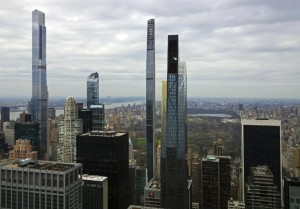Typically today you won’t see an urban setting without some kind of skyscraper. They are incredibly popular because you can create more homes, housing, or commercial space on a smaller piece of land by building up. The designs do create a number of challenges though. We want to have a look at them here to explore a few different solutions. Then, if you need some help with residential architecture in London, you can rely on us.
Solar gain
 The main issue with modern skyscrapers is heating and cooling. Solar gain becomes a serious problem with them, especially when the designs have glass facades. It can make spaces inside quite uncomfortable. That increases the demand for HVAC systems. While the technology is there, it can mean the buildings consume a lot of energy to keep them cool.
The main issue with modern skyscrapers is heating and cooling. Solar gain becomes a serious problem with them, especially when the designs have glass facades. It can make spaces inside quite uncomfortable. That increases the demand for HVAC systems. While the technology is there, it can mean the buildings consume a lot of energy to keep them cool.
Generally the main idea with skyscrapers is to take advantage of the views. So, often they have glass on each side. This goes against the traditional idea of designing with orientation in mind to minimise solar gain. So, heat can become a big issue.
What to try?
There are a number of potential solutions to the issue though that would be far better than relying on HVAC systems. Let’s explore two major ones. They can work for different needs, including high rise residential architecture in London.
Facades
Firstly, you can use responsive, operable facades. This is actually quite an old idea, originally dating back to a pioneering concept in 1987. Here, the idea was to have adjustable apertures between two panes of glass. They could open and close like a camera, working to block out light and solar gain when necessary. It is a good idea, but the first attempt was costly and difficult to maintain.
A newer take on the facades can work really well. What happens here is there is a facade with shading elements in front of the curtain wall. The shades can open and close as necessary to tackle solar gain. Because the shades are outside the property itself, the performance can be fantastic. It means the heat does not even get to enter the interior. In addition, they can offer new opportunities to enhance the aesthetics of the buildings.
Green facades
Secondly, designers can utilise passive design ideas by incorporating green facades into the skyscrapers. It is well known that greenery can naturally help to insulate properties against solar gain to keep them cooler. It can provide incredible natural shading too. So, it is definitely worth a look.
There is a massive concern here though. Some don’t consider green facades for high rise buildings because of fear that the soil and planters will add a lot of weight to the structure. Luckily, there are plenty of lightweight solutions now. This includes simple ideas like planting vines and light foliage using planter slots rather than beds. Steel mesh frames can then support the greenery as it grows up the side of the building.
Green facades can work with operable elements too. For example, they can shade openable glazing. You could even have them on movable shades, as long as moving panels would not damage the greenery.
Speak to us about residential architecture in London
Skyscrapers have become a more and more common piece of the skyline in London in the last decade. It doesn’t show any signs of slowing either with hundreds more in the pipeline. Designers need to think carefully about the designs. They must look at solar gain in particular.
If you are planning a project and want some help, you can rely on us. We’re the most passionate designers of residential architecture in London. Whether it is individual homes, housing developments, or high rises, we’ll create a beautiful design.
